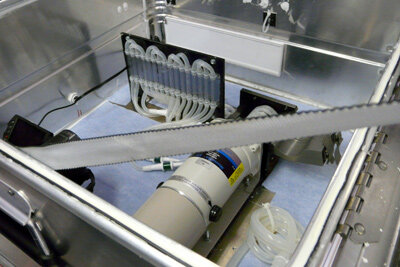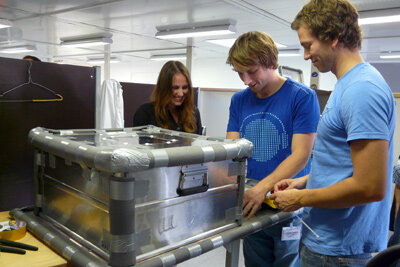Meet the teams
Four teams of postgraduate students flew their experiments during the 2009 'Fly Your Thesis!' campaign. Here is an introduction to the Norwegian team.
![]()
Complex - Microgravity studies of the effect of volume fraction and salinity on flow in samples of clay nanoparticles dispersed in water![]()
![]()
| University | Norwegian University of Science and Technology |
| Endorsing professor |
Professor Dr. Ing. Jon Otto Fossum Norwegian University of Science and Technology |
| ELGRA mentor | Daniel Beyssens |
| Team |
Henrik Hemmen Elisabeth Lindbo Hansen Eirik Voje Blindheim |

Complex is a team of three students from the University of Science and Technology in Trondheim, Norway. The aim of their experiment was to study the flow of clay nanoparticles in salty water in order to provide a deeper understanding of the self-organisation of such small particles.
Smectite clays are layered, plate-like particles with typical sheet diameters in the micrometer range and thicknesses on the order of tens of nanometers. They are present in many important geological sites, such as oil reservoirs. When such particles are dispersed in water, they may orient spontaneously into liquid crystalline phases as a function of the particle concentration, and/or they may orient in response to external influences.
This experiment concerned the basic properties of clay nanoparticles. It investigated flow-induced order in aqueous suspensions of a synthetic smectite clay, sodium fluorohectorite. In particular, it studied the decay of this ordering under microgravity conditions, due to Brownian rotational motion. The study in a weightless environment was important because it eliminated problems related to sedimentation and convection that could interfere with the pure Brownian dynamics of the system.
The experiment involved shining linearly polarised light onto a sample in which a flow was induced prior to the onset of microgravity. Light transmitted from the sample passed a second polariser that was oriented with its transmission axis at 90 degrees to the axis of the first polariser. This light was then recorded by a high definition video camera in order to map the anisotropy induced by the flow.

During the parabolic flight campaign, the Complex experiment was successful and provided the student team with interesting data to be analysed.
The team’s research may have a number of practical applications. For example, a more fundamental understanding of the properties of nanoparticles in flow is essential in key industries, such as storage of nuclear waste, crude oil extraction, and in the development of new, smart, nanoapplications. In addition, the role of flow and orientation of clay particles in soil stability is not yet properly understood, so this experiment may help to prevent catastrophic landslides.
Read more about this experiment on the ERASMUS Experiment Archive.



